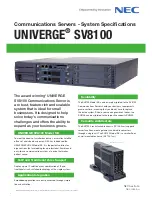Reviews:
No comments
Related manuals for E53S001

Univerge SV8100
Brand: NEC Pages: 2

BladeCenter HS23
Brand: IBM Pages: 30

System x3950 X6
Brand: IBM Pages: 53

8835 - Eserver 325 - 1 GB RAM
Brand: IBM Pages: 68

6C1
Brand: IBM Pages: 42

AQUILADSF
Brand: HYVE Pages: 22

totalstorage 200
Brand: IBM Pages: 152

SRX-Pro Server
Brand: i3 International Pages: 2

Ultrastar Serv24 S2122-N24-4
Brand: HGST Pages: 36

Server 3100 series
Brand: Digital Equipment Pages: 71

N2520 series
Brand: Thecus Pages: 130

CNP-101UW
Brand: CNET Pages: 2

TERASTATION HS-D1.0TGL/R5
Brand: Buffalo Pages: 2

GLS-2101
Brand: Eneo Pages: 94

Express 320Ma
Brand: NEC Pages: 10

AAEON ARES-WHI0
Brand: Asus Pages: 76

TS100-E5/PI4
Brand: Asus Pages: 16

VivoPC
Brand: Asus Pages: 42

















